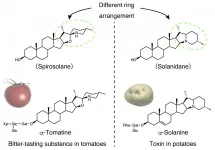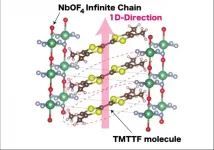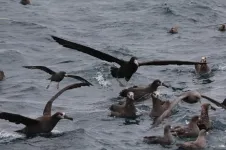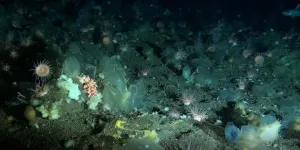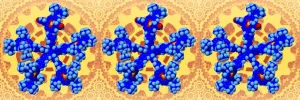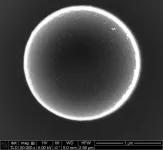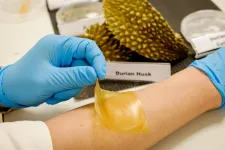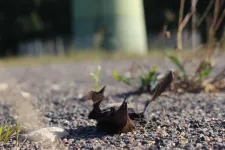(Press-News.org) LA JOLLA--(March 25, 2021) The brush of an insect's wing is enough to trigger a Venus flytrap to snap shut, but the biology of how these plants sense and respond to touch is still poorly understood, especially at the molecular level. Now, a new study by Salk and Scripps Research scientists identifies what appears to be a key protein involved in touch sensitivity for flytraps and other carnivorous plants.
The findings, published March 16, 2021, in the journal eLife, help explain a critical process that has long puzzled botanists. This could help scientists better understand how plants of all kinds sense and respond to mechanical stimulation, and could also have a potential application in medical therapies that mechanically stimulate human cells such as neurons.
"We know that plants sense touch," says co-corresponding author Joanne Chory, director of Salk's Plant Molecular and Cellular Biology Laboratory and holder of the Howard H. and Maryam R. Newman Chair in Plant Biology. "The Venus flytrap, which has a very fast response to touch, provides an opportunity to study a sensory modality that historically has been poorly understood."
Scientists have long been fascinated by Venus flytraps and carnivorous plants; Charles Darwin devoted an entire book to them. But while previous studies have looked at the structural mechanism of their bizarre leaves, not much is known about how they work at the cellular level. That's partly because flytraps are challenging to study. They're extremely slow to grow, and the flytrap genome had not been sequenced until recently, opening the door for deeper genetic research.
"Because they're so unusual, people have been interested in these plants for hundreds of years, so there's quite a bit known about them at the gross, macroscopic level, but the molecular details have been hard to tease out," says Carl Procko, a staff scientist in Salk's Plant Molecular and Cellular Biology Laboratory.
In the new study, the authors grew cloned flytraps from cuttings to get plants that were genetically identical. Then they carefully cut thousands of microscopic, touch-sensitive trigger hairs from these plants and used sequencing technology to identify which proteins were most abundant in the hairs.
Based on previous research, they knew that the proteins involved in sensing touch were likely to have the capability of moving an electrical current across the cell. Sure enough, this type of protein was the second most common type found in the hairs. The scientists named the new protein FLYCATCHER1. To test the protein, colleagues at Scripps Research put it into mammalian cells. The cells responded by producing an electrical current when touched, proving that the protein is sensitive to mechanical stimuli.
The team found the same protein in the tentacles of the sundew, a carnivorous plant that's a close relative of the Venus flytrap. In the sundew, these sticky tentacles sense the movement of a struggling insect, stimulating the leaf to curl up and trap its prey.
"These findings are further evidence that the FLYCATCHER1 protein plays a critical role in the trigger hairs of the Venus flytrap and the mechanisms of the plant that sense and respond to touch," says Chory.
As a next step, the study authors want to do a "knockout" test and grow genetically modified flytraps with the protein missing. If these flytraps are unable to sense touch, it will prove conclusively that the FLYCATCHER1 protein is responsible.
INFORMATION:
Other authors on the study are Swetha E. Murthy, William T. Keenan, Seyed Ali Reza Mousavi, Adam Coombs, and Ardem Patapoutian of Scripps Research; Tsegaye Dabi of Salk; Erik Procko of the University of Illinois at Urbana-Chambaign; and Lisa Baird of the University of San Diego.
The research was supported by the National Institutes of Health and the Howard Hughes Medical Institute. Additional funding was provided by the George E. Hewitt Foundation for Medical Research and the University of San Diego
About the Salk Institute for Biological Studies:
Every cure has a starting point. The Salk Institute embodies Jonas Salk's mission to dare to make dreams into reality. Its internationally renowned and award-winning scientists explore the very foundations of life, seeking new understandings in neuroscience, genetics, immunology, plant biology and more. The Institute is an independent nonprofit organization and architectural landmark: small by choice, intimate by nature and fearless in the face of any challenge. Be it cancer or Alzheimer's, aging or diabetes, Salk is where cures begin. Learn more at: salk.edu.
A multi-institutional collaboration has revealed that α-solanine, a toxic compound found in potato plants, is a divergent of the bitter-tasting α-tomatine, which is found in tomato plants. The research group included Associate Professor MIZUTANI Masaharu and Researcher AKIYAMA Ryota et al. of Kobe University's Graduate School of Agricultural Science, Assistant Professor WATANABE Bunta of Kyoto University's Institute for Chemical Research, Senior Research Scientist UMEMOTO Naoyuki of the RIKEN Center for Sustainable Resource Science, and Professor MURANAKA Toshiya of Osaka University's Graduate School of Engineering.
It ...
Salts are far more complicated than the food seasoning - they can even act as electrical conductors, shuttling current through systems. Extremely well studied and understood, the electrical properties of salts were first theorized in 1834. Now, nearly 200 years later, researchers based in Japan have uncovered a new kind of salt.
The results were published on March 17 in Inorganic Chemistry, a journal of the American Chemical Society.
The researchers were specifically investigating how one-dimensional versions of three-dimensional substances exhibit unique physical phenomena and functionality in a process called the ...
CORVALLIS, Ore. - A novel analysis of encounters between albatross and commercial fishing vessels across the North Pacific Ocean is giving researchers important new understanding about seabird-vessel interactions that could help reduce harmful encounters.
The new research method, which combines location data from GPS-tagged albatross and commercial fishing vessels, allows researchers to accurately identify bird-vessel encounters and better understand bird behavior, environmental conditions and the characteristics that influence these encounters.
"It is hard to conceptualize how often birds ...
For the first time, researchers from the SponGES project collected year-round video footage and hydrodynamic data from the mysterious world of a deep-sea sponge ground in the Arctic. Deep-sea sponge grounds are often compared to the rich ecosystems of coral reefs and form true oases. In a world where all light has disappeared and without obvious food sources, they provide a habitat for other invertebrates and a refuge for fish in the otherwise barren landscape. It is still puzzling how these biodiversity hotspots survive in this extreme environment as deep as 1500 metres below the water surface. With over 700 hundred ...
Ikoma, Japan - Gear trains have been used for centuries to translate changes in gear rotational speed into changes in rotational force. Cars, drills, and basically anything that has spinning parts use them. Molecular-scale gears are a much more recent invention that could use light or a chemical stimulus to initiate gear rotation. Researchers at Nara Institute of Science and Technology (NAIST), Japan, in partnership with research teams at University Paul Sabatier, France, report in a new study published in Chemical Science a means to visualize snapshots of an ultrasmall ...
People who are physically active on a regular basis recover better after surgery for colorectal cancer. However, starting to exercise only after the diagnosis is a fact had no effect on recovery, a University of Gothenburg thesis shows.
In working on his thesis, Aron Onerup, who obtained his doctorate in surgery at the University's Sahlgrenska Academy and is now a specialist doctor at Sahlgrenska University Hospital, carried out an observational study of 115 patients diagnosed with colorectal cancer.
The participants who had been physically inactive proved, three weeks after their surgery, to be at higher risk of not feeling that they ...
Microswimmers are artificial, self-propelled, microscopic particles. They are capable of directional motion in a solution. The Molecular Nanophotonics Group at Leipzig University has developed special particles that are smaller than one-thirtieth of the diameter of a hair. They can change their direction of motion by heating tiny gold particles on their surface and converting this energy into motion. "However, these miniaturised machines cannot take in and learn information like their living counterparts. To achieve this, we control the microswimmers externally so that they learn to navigate in a virtual environment through what is known as reinforcement learning," said Cichos.
With the help of virtual rewards, the microswimmers find their way through the liquid ...
Food scientists from Nanyang Technological University, Singapore (NTU Singapore) have made an antibacterial gel bandage using the discarded husks of the popular tropical fruit, durian.
Known as the "King of Fruits" in Southeast Asia, the durian has a thick husk with spiky thorns which is discarded, while the sweet flesh surrounding the seeds on the inside is considered a delicacy.
By extracting high-quality cellulose from the durian husks and combining it with glycerol - a waste by-product from the biodiesel and soap industry - NTU scientists created a soft gel, similar to silicon sheets, which can be cut into bandages of various shapes and sizes.
They then added the organic molecules produced from baker's yeast known as natural yeast phenolics, making the bandage deadly ...
In order to assess the risk of bats dying at wind turbines, it is common practice to record the acoustic activity of bats within the operating range of the rotor blades. For this purpose, ultrasonic detectors are attached to the nacelles of the mast top. In a recent analysis, a team of scientists led by the Leibniz Institute for Zoo and Wildlife Research (Leibniz-IZW) concludes that the effectiveness of this acoustic monitoring is insufficient to reliably predict mortality risk, especially for bats at large turbines. They therefore recommend installing supplementary ultrasonic detectors at other locations on the wind turbines and developing additional techniques such as radar and thermal imaging cameras for monitoring. The results of their analysis are published in ...
European listed companies in the energy and mining sector provide, to say the least, sparse information on future environmental costs in their annual reports. Researchers believe that stricter guidelines are required as the lack of information may lead to underestimation of environmental liabilities, resulting in that future generations may have to bear the burden of cleanup costs.
"I believe that the future environmental liabilities such as decommissioning costs are often underestimated and few understand the burden these costs might impose on future generations. If, for example, an oil & gas company fails, it costs an incredible amount to clean up after old oil wells and the risk is great that the taxpayers will have to pay the bill. Therefore, it is important that environmental obligations ...
